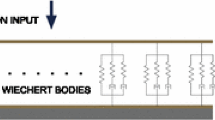Summary
One of the main objectives of control algorithms for teleoperation systems is to have a master device mimicking the response of the remote environment, while the slave device is requested to behave as the human operator. In general, the remote environment is compliant, with a quite different behavior with respect to perfectly rigid surfaces (e.g. in surgery or humancentered applications). In these cases, the knowledge of the dynamical properties of the remote environment can be used in order to improve the transparency of the overall system. A number of analytical and computational models have been proposed in literature in order to describe the behavior of compliant materials but, for sake of simplicity, design and simulation of controllers for robotic telemanipulation are still tied to classical linear spring-damper models. On the other hand, previous experimental activities with soft materials and human tissues have demonstrated that they are characterized by dynamical effects (relaxation and creep phenomena), which cannot be taken into account by means of linear, low-order models. In this Chapter, we study the suitability of a class of nonlinear contact models to describe and emulate compliant visco-elastic environments. Their parameters, estimated on-line, can then be used to command a suitable behavior to the master device in order to render a better contact sensation to the user.
Access this chapter
Tax calculation will be finalised at checkout
Purchases are for personal use only
Preview
Unable to display preview. Download preview PDF.
Similar content being viewed by others
References
P. Arcara and C. Melchiorri. MISTRAL: Methodologies and Integration of Subsystems and Technologies for Anthropic Robots and Locomotion, chapter Comparison and Improvement of Control Schemes for Robotic Teleoperation Systems with Time Delay. Springer-Verlag, 2003.
J.E. Colgate. Robust impedance shaping telemanipulation. IEEE Transactions on Robotics and Automation, 9(4), 1993.
S. Hirche and M. Buss. Passive position controlled telepresence systems with time delay. In American Control Conference, volume 1, Denver, USA 2003.
D. Erickson, M. Weber, and I. Sharf. Contact stiffness and damping estimation for robotic systems. Int. Jour. of Robotic Research, vol. 22, 2003.
K.H. Hunt and F.R.E. Crossley. Coefficient of restitution interpreted as damping in vibroimpact. ASME Journal of Applied Mechanics, pages 440–445, 1975.
K. L. Johnson. Contact Mechanics. Prentice Hall International Editions, 1995.
W. N. Findley, J.S. Lai, and K. Onaran. Creep and Relaxation of Nonlinear Viscoelastic Materials. North-Holland Publishing Company, 1976.
S. Misra abd A. M. Okamura. Environment parameter estimation during bilateral telemanipulation. In Symposium on Virtual Interfaces for Virtual Environment and Teleoperator Systems, Alexandria, Virginia, USA, 2006.
Y. Yokokohji and T. Yoshikawa. Bilateral control of master-slave manipulators for ideal kinesthetic coupling. In IEEE International Conference on Robotics and Automation, Nice, France, 1992.
B. Hannaford. A design framework for teleoperators with kinesthetic feedback. IEEE Transactions on Robotics and Automation, 5(4), 1989.
G. De Gersem, H. Van Brussel, and J. Vander Sloten. Enhanced haptic sensitivity for soft tissues using teleoperation with shaped impedance reflection. In World Haptics Conference, Pisa, Italy, 2005.
K. Hashtrudi-Zaad and S.E. Salcudean. Adaptive transparent impedance reflecting teleoperation. In IEEE International Conference on Robotics and Automation, Minneapolis, Minnesota, 1996.
K. B. Shimoga and A. A. Goldenberg. Soft robotic fingertips-part ii: A comparison of construction materials. The Int. Journal of Robotic Research, 15(4), 1996.
H. C. Güler, N. Berme, and S. R. Simon. A viscoelastic sphere model for the representation of plantar soft tissue during simulations. Jour. of Biomechanics, 31:847–853, 1998.
M. Shibata and S. Hirai. Stability and graspability analysis in grasping task taking fingertip dynamics into consideration. In Proc. of IEEE Int. Conf. on Intelligent Robots and Systems, IROS’04, Sendai, Japan, 2004.
K.H. Hunt and F.R.E. Crossley. Coefficient of restitution interpreted as damping in vibroimpact. ASME Journal of Appl. Mech., 1975.
D.W. Marhefka and D.E. Orin. A compliant contact model with nonlinear damping for simulation of robotic systems. IEEE Trans. on Systems, Man and Cybernetics, 29(6), 1999.
P.R. Kraus and V. Kumar. Compliant contact models for rigid body collisions. In Proc. of IEEE Int. Conf. on Robotics and Automation, ICRA’97, 1997.
N. Diolaiti, C. Melchiorri, and S. Stramigioli. Contact impedance estimation for robotic systems. IEEE Trans. on Robotics and Automation, 21(5), 2005.
Y.C. Fung. Biomechanics: Mechanical Properties of Living Tissues. Springer-Verlag, 1993.
W. N. Findley and J. S. Y. Lay. A modified superposition principle applied to creep of nonlinear viscoelastic material under abrupt changes in state of combined stress. Trans. of the Society of Rheology, vol. 11(3):361–380, 1967.
A. C. Pipkin and T. G. Rogers. A non-linear integral representation for viscoelastic behaviour. Jour. of Mech. Phys. Solids, vol. 16, 1967.
L. Ljung and T. Södertström. Theory and Practice of Recursive Identification. The MIT Press, Cambridge, Massachusetts, 1983.
K.J. Hunt, M. Munih, N. Donaldson, and F.M.D. Barr. Investigation of hammertein hypothesis in the modelling of electrically stimulated muscle. IEEE Transactions on Biomedical Enginering, 45(8), 1998.
E. Eskinat, SH. Johnson, and W.L. Luyben. Use of hammerstein models in identification of nonlinear systems. AIChE Journal, 37(2), 1991.
K.S. Narendra and P.G. Gallman. An iterative method for the identification of the nonlinear systems using the hammerstein model. IEEE Transactions on Automatic Control, 12, 1966.
I. Kao and F. Yang. Stiffness and contact mechanics of soft fingers in grasping and manipualtion. IEEE Trans. on Robotics and Automation, 20(1), 2004.
L. Biagiotti, C. Melchiorri, P. Tiezzi, and G. Vassura. Modelling and identification of soft pads for robotic hands. In Proc. of IEEE Int. Conf. on Intelligent Robots and Systems, IROS’05, 2005.
Author information
Authors and Affiliations
Editor information
Editors and Affiliations
Rights and permissions
Copyright information
© 2007 Springer-Verlag Berlin Heidelberg
About this chapter
Cite this chapter
Biagiotti, L., Melchiorri, C. (2007). Environment Estimation in Teleoperation Systems. In: Ferre, M., Buss, M., Aracil, R., Melchiorri, C., Balaguer, C. (eds) Advances in Telerobotics. Springer Tracts in Advanced Robotics, vol 31. Springer, Berlin, Heidelberg. https://doi.org/10.1007/978-3-540-71364-7_14
Download citation
DOI: https://doi.org/10.1007/978-3-540-71364-7_14
Publisher Name: Springer, Berlin, Heidelberg
Print ISBN: 978-3-540-71363-0
Online ISBN: 978-3-540-71364-7
eBook Packages: EngineeringEngineering (R0)




